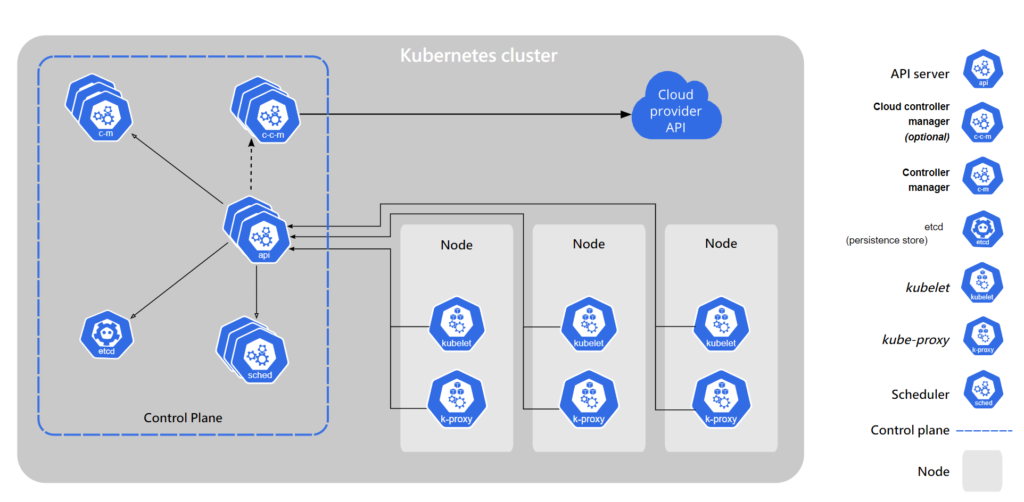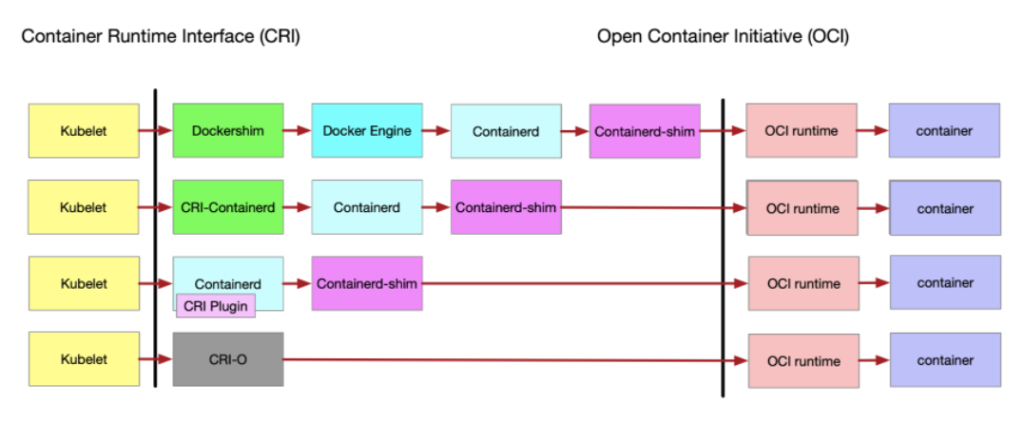Main components

- Each Node (machine) includes a kubelet and many Pods
- Kubelets communicate with the Control Plane (actually a special node) and the corresponding Pods inside the Node
- Control Plane can be split into multiple machines
- Each Pod serves as an application and has many containers which are tightly coupled
- Containers inside the same Pod share the same networking resource
- kube-apiserver: Exposes the Kubernetes API
- etcd: Key value store
- kube-scheduler: Schedule Nodes to run Pods
- kube-controller-manager: Many components deal with monitoring, task running, and account access control
History of container runtime

- From the oldest method (top) to newest approach (bottom)
- CRI is an interface designed for kubelet to manipulate containers
- Any CRI-compliant container runtime can do the job: Docker Engine, containerd, CRI-O, …
- OCI runtime: runC, runhcs, …
K8s entity concepts

- A Deployment checks on the health of your Pod and restarts the Pod’s container if it terminates. Deployments are the recommended way to manage the creation and scaling of Pods
- Deployment configuration file works very similar to
docker-compose.yml - Deployment controller automatically search for a suitable node where an instance of the application could be run
- If the Node hosting an instance goes down or is deleted, the Deployment controller replaces the instance with an instance on another Node in the cluster
- A Service is an exposed Deployment, which encapsulates a set of Pods called ReplicaSet
- Secrets and ConfigMap are extra resources we can mount into containers
- Volumes types:
- emptyDir: Storage lives with a Pod
- hostPath: Storage lives with a Node
- NFS and other cloud provider type
- Storage
- Storage Classes: Templates to create volumes
- Persistent Volume Claims: Create (or use existing) PV by specifying SC, size, read/write type etc. We can then attach a PVC into a Pod config
- Persistent Volumes: Either created manually (static) or automatically (dynamic) when no any PV match the claim
- Resource
- Request: minimum requirement
- Quota: maximum limit
Common tools
- cri-o: A container runtime
- kubelet: Starts pods and containers
- kubectl: The command line util to talk to your cluster.
- kubeadm: The command to bootstrap the cluster (control planes etc.)
- minikube: A tool to quickly setup a single-node cluster inside a VM
- Kops: Setup AWS clusters easily
Networking
- Each Node has its own node IP (as normal machines) which is mainly accessed by the control plane node
- Each Pod has its own IP, where the Node will forward the request to
- Pods inside each Node, or across Nodes, can see each other using Pod IPs, but not recommended to do so. Exposing the endpoint as a service is preferred
- Containers inside the same Pod can refer to each other using
localhost:port, this is like running up docker-compose inside a “pod machine”, but the container network is configured as host - Services have Cluster IPs and domain name, for intra-cluster access
- Port definitions:
- port: For intra-cluster access
- nodePort: Exposed port on the Node
- targetPort: Container port
- Ingress along with ingress controller act like an Nginx load balancer. The DNS record should point to this load balancer IP to serve services across multiple Nodes
